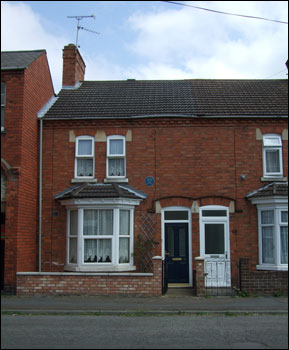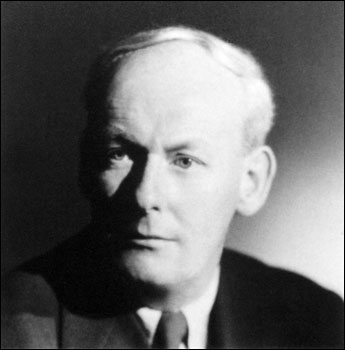Herbert Ernest Bates was born on the 16th of May 1905 and he was the first boy to be Christened in the new Wesleyan Methodist Church built, alongside the old one, in Park Road. His parents, Albert and Lucy Bates, had married at the Methodist Church at Higham Ferrers on the 1st of June 1903, and were then living at 51 Grove Road.
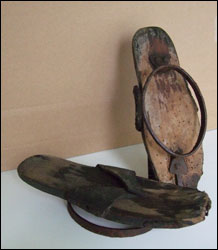 |
|
These patens belonged to Priscilla Lucas (nee Bird). They have been donated to Rushden Museum by John Gray, a descendant. The metal ring, under the wooden sole, lifted the wearer's shoes out of mud or water. A leather strap on top to secure.
|
Albert Bates was born in 1880, son of Deborah Bates and Charles Lawrence, and his mother died when he was just three years old. He married Lucy Elizabeth Lucas, who was born at Higham Ferrers in 1878, was daughter of George William Lucas and Priscilla (nee Bird - of Souldrop).
Grandfather George Lucas, a shoemaker, would take Herbert out into the countryside for walks, and this is where he learnt to appreciate the plants and wild life of the area of North Bedfordshire where his grandmother's family came from, and of Northamptonshire around Rushden. Charles would also tell the young lad tales as they walked. His grandfather had become a smallholder, with a piece of land close to Chelveston, and when the airbase was built this land was given up to that development.
Herbert's early schooling was at Newton Road and he went on to Kettering Grammar School where he enjoyed football and athletics. His English teacher there was Edmund Kirby, who was to influence his studies of literature and poetry. He became a frequent borrower of books from Rushden Carnegie Library which had opened when he was just a few months old.
He left school at 16 and became a junior reporter with the Northampton Chronicle, based at the Wellingborough branch office. He then took a job as a clerk for a leather merchant in Rushden and it was there he penned his first novel 'The Two Sisters'. After a struggle, and on the dole, in 1925 he found a company willing to publish this book and H.E. as he was now known, was just 21 years old.
In 1931 he married Marjorie Helen Cox (Madge), daughter of Herbert Henry Cox, a currier from Higham Ferrers who had died five years earlier, and Frances (nee Bailey).
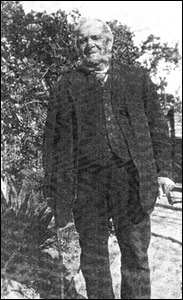 |
|
Joseph Betts - Uncle Silas
|
|
H.E. and Madge moved to Little Chart in Kent, where they bought an old granary which they renovated and laid out a beautiful garden where there had been wilderness. In this environment he could write and he quickly gained a reputation for writing short stories about country ways. During World War II he continued to write his stories, alongside his duties in the R.A.F. as a writer, under a pseudonym 'Flying Officer X'.'Love for Lydia' was inspired by a visit inside Rushden Hall, and the town of Rushden was called Evensford in Bates' books. In some of his stories he wrote about several people who were identifiable to the locals. One such man was his Great Uncle Joseph Betts, whose likeness was interwoven with Uncle Silas in a series of stories, and Sam Smith had been a chum with whom he had learnt a little about poaching as they had walked the countryside together, and was the basis for the book 'The Poacher'. He dedicated several of his books to the people who had influenced his life. He also published three volumes of autoboigraphy, 'The Vanished World', 'The Blossoming World' and 'The World in Ripeness', in 1969, 1971 and 1972.
Madge and H.E. had four children, Ann, Judith, Richard and Jonathan, and each was given a small plot of garden to tend and this taught them the same love of nature.
In 1966 following a serious illness, H.E. also wrote a book about gardening and a second was published posthumously. He died in 1974, just six months after receiving a C.B.E.
Fame came again, in 1991, when his son Richard produced a television series based on the Pop Larkin family in 'The Darling Buds of May', written in 1958.
|
The Rushden Echo and Argus, 21st January 1955, transcribed by Jim Hollis
Part of the 'Spotlight on Rushden' series
Young Bert had a room with a view
There is a room with a view in Essex Road, Rushden – a view of the houses opposite. Not very inspiring, perhaps, but it is an historic room. In it H. E. Bates wrote his first novel.
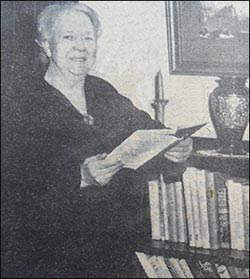 |
|
Mrs Bates, mother of famous novelist H E Bates, has many mementoes of him at her home in Essex Road, where, in an upstairs room set apart as a study, he wrote his first novels. Here she is with one of his later books.
|
The house is Manton Cottage, and there during his formative years he lived with his mother and father, and Edna and Stanley, his sister and brother.He went, a small fair-haired, jerseyed figure, to Newton Road School, and in the evenings his father – a musician and a great reader – used to talk to him.
Then the house saw him going off with his satchel to Kettering Grammar School (he won a scholarship), to the Methodist Sunday School, where he was a teacher, to his first job as a reporter (which he didn’t like), and then to a leather warehouse (which gave him time to start writing as he wished).
House of Memories
Today his mother still lives in Essex Road, Mr. Bates, senior, died four years ago and the children have married, but the house pulses with memories.
Mrs. Bates remembers Bert’s determination at work and play. He trained for the Grammar School sports by going out in running shorts and vest at 6 a.m. and making a wide circuit of the outskirts of Rushden. It paid dividends – he brought back several “pots”.
His speed took him into the K.G.S. football team, and he was in several school plays – “but not the chief parts.”
Spectacular Spill
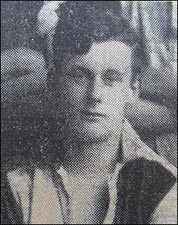 |
|
One of Mrs Bates' collection of photos of her famous son, as a member of the football team at Kettering Grammar School, season 1921-22.
|
The author, who as since graduated to a large dignified saloon, began his motoring career on a motor bike, but his enthusiasm for two wheels waned after a spectacular spill, en route for a cricket match.
When he began to write, he preferred walking. He would often walk to Sharnbrook to see the relative who, in time, inspired the creation of Uncle Silas.
So the days and nights of literary struggle in that little room with a view began – the struggle that led to fame.
H. E. Bates married, went to live in Kent, and won his way to the front rank of English writers.
In his boyhood home in Rushden his mother treasures among the family souvenirs photographs that mark every step of the way.
Bert as a baby, Bert in the school play, Bert and Madge on their wedding day, Bert playing cricket with his kiddies, Bert in “Flying Officer X” uniform, Bert in grey topper off to the Royal garden party.
And up in the little room – “it’s a lumber room now” – still lie some of the things he used when he first began to write.
|
|
